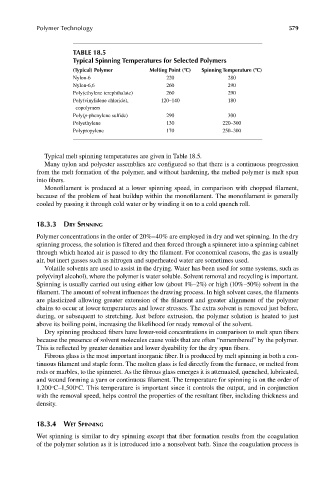Page 616 - Carrahers_Polymer_Chemistry,_Eighth_Edition
P. 616
Polymer Technology 579
TABLE 18.5
Typical Spinning Temperatures for Selected Polymers
o
o
(Typical) Polymer Melting Point ( C) Spinning Temperature ( C)
Nylon-6 220 280
Nylon-6,6 260 290
Poly(ethylene terephthalate) 260 290
Poly(vinylidene chloride), 120–140 180
copolymers
Poly(p-phenylene sulfi de) 290 300
Polyethylene 130 220–300
Polypropylene 170 250–300
Typical melt spinning temperatures are given in Table 18.5.
Many nylon and polyester assemblies are configured so that there is a continuous progression
from the melt formation of the polymer, and without hardening, the melted polymer is melt spun
into fi bers.
Monofilament is produced at a lower spinning speed, in comparison with chopped fi lament,
because of the problem of heat buildup within the monofilament. The monofilament is generally
cooled by passing it through cold water or by winding it on to a cold quench roll.
18.3.3 DRY SPINNING
Polymer concentrations in the order of 20%–40% are employed in dry and wet spinning. In the dry
spinning process, the solution is filtered and then forced through a spinneret into a spinning cabinet
through which heated air is passed to dry the fi lament. For economical reasons, the gas is usually
air, but inert gasses such as nitrogen and superheated water are sometimes used.
Volatile solvents are used to assist in the drying. Water has been used for some systems, such as
poly(vinyl alcohol), where the polymer is water soluble. Solvent removal and recycling is important.
Spinning is usually carried out using either low (about 1%–2%) or high (10%–50%) solvent in the
filament. The amount of solvent influences the drawing process. In high solvent cases, the fi laments
are plasticized allowing greater extension of the filament and greater alignment of the polymer
chains to occur at lower temperatures and lower stresses. The extra solvent is removed just before,
during, or subsequent to stretching. Just before extrusion, the polymer solution is heated to just
above its boiling point, increasing the likelihood for ready removal of the solvent.
Dry spinning produced fibers have lower-void concentrations in comparison to melt spun fi bers
because the presence of solvent molecules cause voids that are often “remembered” by the polymer.
This is reflected by greater densities and lower dyeability for the dry spun fi bers.
Fibrous glass is the most important inorganic fiber. It is produced by melt spinning in both a con-
tinuous filament and staple form. The molten glass is fed directly from the furnace, or melted from
rods or marbles, to the spinneret. As the fibrous glass emerges it is attenuated, quenched, lubricated,
and wound forming a yarn or continuous filament. The temperature for spinning is on the order of
o
o
1,200 C–1,500 C. This temperature is important since it controls the output, and in conjunction
with the removal speed, helps control the properties of the resultant fiber, including thickness and
density.
18.3.4 WET SPINNING
Wet spinning is similar to dry spinning except that fiber formation results from the coagulation
of the polymer solution as it is introduced into a nonsolvent bath. Since the coagulation process is
9/14/2010 3:43:37 PM
K10478.indb 579 9/14/2010 3:43:37 PM
K10478.indb 579

